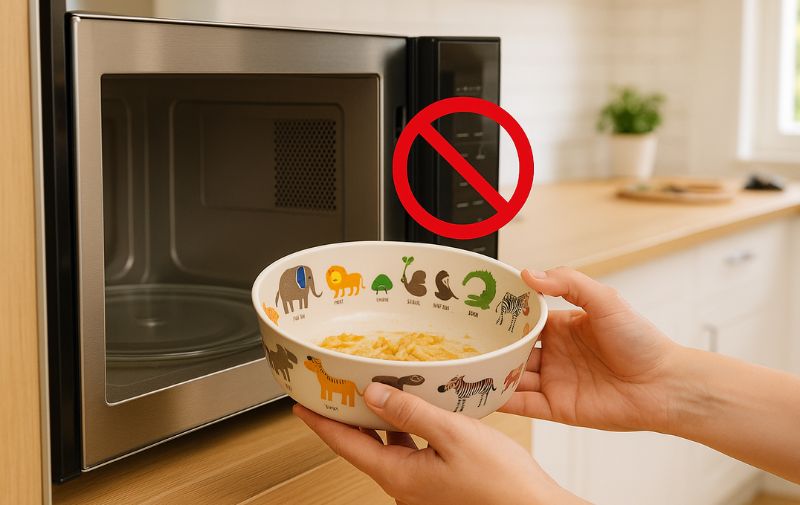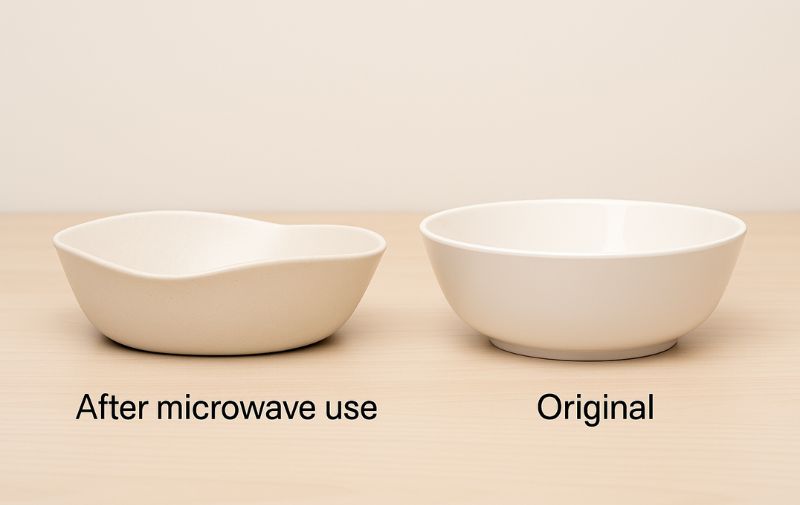So, you’re wondering, “Are melamine bowls microwave safe?” Let’s get straight to the point: No, your melamine bowls are absolutely NOT microwave safe. While they might look sturdy and convenient, putting melamine in the microwave can damage the bowl, pose a burn risk, and potentially lead to increased chemical leaching into your food over time.
This guide will explain exactly why microwaving melamine bowls is a bad idea and what you should do instead to keep your meals safe and your dinnerware in top shape.
Last Updated: May 2025 | Estimated Reading Time: 7 minutes

What Happens When Melamine Bowls Meet the Microwave?
You might think your sturdy melamine bowl can handle a quick spin in the microwave, but what’s really going on is quite different from what you expect. Unlike materials designed for microwave use, melamine resin, even high-quality A5, actively absorbs microwave energy. Instead of the microwaves passing through the bowl to primarily heat your food, the bowl itself gets incredibly hot. This isn’t just inefficient; it’s the starting point for several problems.
Is it generally recommended to microwave food in melamine bowls?
Absolutely not. No reputable melamine dinnerware manufacturer will recommend or endorse using their products in a microwave. In fact, you’ll almost always find a “Not for microwave use” warning on the product label or care instructions. This isn’t a casual suggestion – it’s a critical directive for both safety and to maintain the integrity of your bowl. Ignoring this often voids any product warranty.
Can heating melamine in a microwave cause chemicals to leach into your food?
Yes, heating melamine in a microwave can increase the risk of chemicals leaching into your food over time. While a single, accidental brief microwaving of high-quality A5 melamine is unlikely to cause immediate poisoning, the intense heat absorbed by the resin causes it to degrade. This degradation process can:
Damage the Bowl Structurally
The bowl can warp, crack, blister, or develop a chalky, dull surface.
Increase Leaching Potential
As the material breaks down from repeated (or even a single significant) microwave exposure, the likelihood of small amounts of melamine or formaldehyde migrating into your food increases.
This risk is higher with acidic foods (like tomato sauce) or fatty foods. It’s crucial to remember that safety tests for melamine tableware are conducted on new products, not on products that have been repeatedly stressed by microwave heat.
Industry Insight
The core issue isn’t typically immediate, acute toxicity from one accidental use. It’s about the cumulative material degradation that compromises the bowl’s integrity and can elevate the risk of chemical migration over time.
What Are the Specific Risks of Microwaving Melamine?
Beyond the general unsuitability, there are specific, tangible risks involved when you try microwaving melamine bowls. These aren’t just theoretical; they are practical dangers and damage you can observe.
How does temperature affect melamine’s safety in a microwave?
This is a major, often overlooked hazard: the melamine bowl can get significantly hotter than the food it contains. Because the melamine material itself absorbs microwave energy, its surface temperature can soar to dangerous levels, creating a serious burn risk when you try to handle it. Many people are unpleasantly surprised by how hot the bowl gets, not just the food.
Does the acidity of food, like tomato sauce, increase risks when microwaving melamine?
Yes, acidic foods (and also very fatty foods) can exacerbate the risks when heated in melamine, especially if the melamine has been compromised by microwave heat. While melamine is generally stable with these foods at room temperature or during normal serving of hot food (not microwaved), the combination of high heat from microwaving and acidity can accelerate any potential chemical migration from a degrading bowl.

What did studies find about melamine levels in people using melamine bowls for hot food?
Studies by organizations like the FDA have looked at melamine migration from tableware into hot foods (like hot soup served in a bowl). For new, good-quality melamine used as intended (i.e., not microwaved), the migration levels are generally considered within safe limits.
However, these studies do not reflect the scenario of microwaving the melamine itself. Microwaving fundamentally changes the conditions and stresses the material in a way it’s not designed for, making post-microwaving leaching a different and more concerning issue.
| Feature Comparison | Melamine Bowl in Microwave | Microwave-Safe Bowl (Glass/Ceramic) | Your Safety & Practical Takeaway |
|---|---|---|---|
| Microwave Interaction | Absorbs energy, heats up itself | Allows energy to pass to food | Melamine gets dangerously hot; food heats unevenly. |
| Material Integrity | Degrades, warps, cracks, blisters | Stable, designed for microwave heat | Microwaving damages melamine, drastically reducing its life. |
| Leaching Risk (Post-Heat) | Increased potential with degradation | Minimal if material is intact | Avoid microwaving melamine to prevent increased leaching. |
| Burn Hazard from Bowl | High (bowl can be hotter than food) | Low (food primarily heats) | Melamine poses a significant burn risk from the bowl. |
| Chemical Smell | Can emit odor if overheated | No chemical odor | An odor means the melamine is breaking down. |
Why Exactly Is Melamine Not Considered Safe for Microwave Use?
The core reason melamine bowls can’t be microwaved safely lies in the fundamental properties of melamine-formaldehyde resin, the material they’re made from.
What are the properties of melamine that make it unsuitable for microwave heating?
- Microwave Energy Absorption: Unlike glass or microwave-safe ceramics and plastics that are largely transparent to microwaves (allowing them to pass through and heat the food), melamine resin absorbs this energy directly.
- Overheating and Degradation: This absorption causes the melamine material itself to heat up rapidly and intensely. This extreme heat can break down the resin’s structure.
- Structural Damage: You might see warping, blistering, cracking, or a chalky, pitted surface. The bowl loses its smooth, non-porous finish.
- Reduced Lifespan & Appearance: Microwaving drastically shortens the functional life and ruins the aesthetic appeal of melamine dinnerware. It becomes dull, stains more easily (due to surface damage), and looks worn out much faster. This means higher replacement costs for homes and businesses.
- The “Chemical Smell” Indicator: If you’ve ever accidentally microwaved melamine and noticed a distinct, unpleasant chemical odor, that’s a clear warning sign. It indicates the material is overheating and potentially breaking down components of the resin.
Key Confusion Debunked: “Dishwasher Safe” ≠ “Microwave Safe” This is a very common point of confusion. Melamine is generally dishwasher safe because the water temperatures (even in sanitizing cycles, typically 140-160°F or 60-71°C) are lower, and the heat exposure is indirect (hot water and air) rather than direct energy absorption from microwaves.
These are two entirely different types of stress on the material. Just because it can handle the dishwasher doesn’t mean it’s safe for the intense, direct energy of a microwave.
Is a Melamine Bowl Oven-Safe, or Does That Pose Similar Risks?
If it’s not good for the microwave, you might wonder about a conventional oven. No, melamine bowls are definitely NOT oven-safe.
Why should melamine dinnerware not be used for cooking in a conventional oven?
Melamine is not designed to withstand the sustained high temperatures of a conventional oven, even at relatively low oven settings.
- Lower Heat Tolerance: It will warp, melt, char, or even crack at typical oven cooking temperatures (often starting from 160°F / 70°C, but definitely by 250°F / 121°C and above, it will be significantly affected).
- Fume Release: Heating melamine in an oven can cause it to release potentially harmful fumes.
- Not Designed for Cooking: It’s created for serving, not for cooking or baking processes.

What Should You Do Instead of Microwaving Melamine Bowls?
The solution is simple and ensures both your safety and the longevity of your melamine dinnerware: always transfer food to a genuinely microwave-safe container before heating.
What are safer alternatives for heating food in a microwave?
- Glass Containers: Look for borosilicate glass (like Pyrex) or other glassware explicitly labeled “microwave safe.” Glass is non-reactive and heats food evenly.
- Microwave-Safe Ceramics: Many ceramic dishes are microwave safe, but always check the bottom for a “microwave safe” label or symbol. Some glazes on decorative ceramics can contain metals that are not microwave safe.
- Microwave-Safe Plastics: Use plastics specifically designed and labeled for microwave use (often #5 Polypropylene – PP). Ensure they are also BPA-free.
- Paper Plates (Plain): For quick reheats of non-greasy items, plain white paper plates (no plastic coating, no metallic print) can be used, but they are not suitable for all foods.
Safer Microwaving: A Quick Comparison
| Material Alternative | Benefits for Microwaving | What to Look For on Product | Why It’s a Better Choice Than Melamine |
|---|---|---|---|
| Glass | Non-reactive, heats food evenly, no leaching | “Microwave Safe,” Brand (e.g., Pyrex) | Doesn’t absorb microwaves, won’t degrade or leach |
| Ceramic | Good heat retention, often aesthetic | “Microwave Safe” symbol/text | Stable at microwave temps, won’t get overly hot |
| Safe Plastics (PP) | Lightweight, less breakable | “Microwave Safe,” #5 PP, “BPA-Free” | Designed for microwave use, stable, no harmful leaching |
2025 Latest on Melamine Microwave Safety
Despite ongoing advancements in material science, the fundamental properties of melamine-formaldehyde resin that make it unsuitable for microwave use remain unchanged. The advice for 2025 and beyond is consistent and firm: do not microwave melamine products.
Current research continues to support that the direct energy absorption by melamine leads to material degradation and potential safety concerns not present with its intended use. Prioritize using materials explicitly designed and tested for microwave safety.
Common Questions About Microwaving Melamine
Q1: Can you microwave melamine bowls even for a very short time, like 10-15 seconds?
No, it’s best to avoid it altogether. Even short bursts of microwave energy contribute to the cumulative stress and degradation of the melamine. The resin still absorbs energy, and the risk of the bowl overheating or starting to break down exists.
Q2: What happens if I accidentally microwaved my melamine bowl once? Am I in danger?
A single, brief accidental microwaving is unlikely to cause immediate, severe harm, especially with high-quality A5 melamine. However, inspect the bowl carefully for any signs of damage (warping, chalkiness, cracks, odd smell). Avoid using it again in the microwave. The main concern is repeated exposure leading to degradation.
Q3: Why do so many people think melamine is microwave safe if it’s not?
The primary reasons are:
1. Appearance: Melamine looks and feels like a very sturdy plastic, leading to assumptions it shares properties with microwave-safe plastics.
2. "Dishwasher Safe" Confusion: People incorrectly assume dishwasher safety implies microwave safety (as explained above, these are different stresses).
Q4: Does the brand or quality (e.g., A5 melamine) of the bowl matter for microwave safety?
While higher quality A5 melamine or bamboo fibre is more durable for its intended use (serving food, dishwasher cleaning), no melamine, regardless of brand or grade, is safe or recommended for microwave use. The fundamental property of the resin absorbing microwave energy applies to all melamine.
Q5: My melamine bowl doesn’t say “Not for microwave use.” Is it okay then?
Even if a warning is missing (which is rare for reputable brands), the science remains: melamine resin absorbs microwave energy and will heat up, degrade, and potentially become a hazard. Always err on the side of caution and use glass or ceramic instead.
Summary & Your Safest Bet
To put it plainly: melamine bowls and microwaves are not friends. Microwaving melamine can:
- Cause the bowl itself to become dangerously hot (a burn risk).
- Lead to material degradation (warping, cracking, blistering).
- Potentially increase the leaching of chemicals into your food over time.
- Significantly shorten the lifespan and ruin the appearance of your bowls.
Your safest and smartest action is always to transfer food from a melamine bowl to a container made of glass, microwave-safe ceramic, or microwave-safe plastic before heating it in the microwave. It’s a simple extra step that protects your health, preserves your dinnerware, and ensures your food is heated safely and effectively.
Recommended Internal & External Links:
- FDA: Melamine in Tableware – Questions and Answers (Authoritative source on melamine safety in general)
- Good Housekeeping Institute: What Not to Put in a Microwave (General consumer advice, often mentions melamine)


